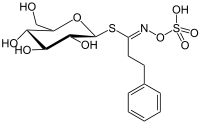Gluconasturtiin
 | |
| Names | |
|---|---|
| IUPAC name
{[3-phenyl-1-{[(2S,3R,4S,5S,6R)-3,4,5-trihydroxy-6- (hydroxymethyl)-2-tetrahydropyranyl]thio}propylidene]amino} hydrogen sulfate | |
| Other names
Phenethylglucosinolate | |
| Identifiers | |
| 499-30-9 | |
| ChemSpider | 7827541 |
| |
| Jmol-3D images | Image |
| PubChem | 9548618 |
| |
| Properties | |
| C15H21NO9S2 | |
| Molar mass | 423.461 g/mol |
| Except where noted otherwise, data is given for materials in their standard state (at 25 °C (77 °F), 100 kPa) | |
| | |
| Infobox references | |
Gluconasturtiin (phenethylglucosinolate) is one of the most widely distributed glucosinolates in the cruciferous vegetables, mainly in the roots, and is probably one of the plant compounds responsible for the natural pest-inhibiting properties of growing crucifers, such as cabbage, mustard or rape, in rotation with other crops. This effect of gluconasturtiin is most likely due to its degradation by the plant enzyme myrosinase into phenethyl isothiocyanate, which is toxic to many organisms.
Gluconasturtiin is named from its occurrence in watercress (Nasturtium officinale). Among the vegetables, it is also found in horseradish (Armoracia rusticana) along with sinigrin. Both compounds elicit a pungent taste.[1]
In one investigation of horseradish roots, sinigrin concentration represented 83% and gluconasturtiin 11% of the extracted glucosinolates.[2]
References
- ↑ (French) RICHARD H. Arômes alimentaires PDF Document
- ↑ XIAN LI, KUSHAD MM (2004) Correlation of glucosinolate content to myrosinase activity in horseradish (Armoracia rusticana). J Agric Food Chem (52)23, pp. 6950-6955